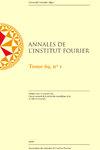Wild monodromy of the Fifth Painlevé equation and its action on wild character variety: an approach of confluence
IF 0.7
4区 数学
Q2 MATHEMATICS
引用次数: 2
Abstract
— The article studies the nonlinear Stokes phenomenon at the irregular singularity of the Fifth Painlevé equation from the point of view of confluence from the Sixth Painlevé equation. This approach is developed separately on both sides of the Riemann–Hilbert correspondence. On the side of the Painlevé–Okamoto foliation, the relation between the nonlinear monodromy group of Painlevé VI and the “nonlinear wild monodromy pseudogroup” of Painlevé V (the pseudogroup generated by nonlinear Stokes operators and nonlinear exponential torus) is explained. On the side of the associated linear isomonodromic problems, the “wild” character variety (the space of the linear monodromy and Stokes data) of Painlevé V is constructed through a birational transformation from the one of Painlevé VI. Explicit formulas for the action of the “nonlinear wild monodromy” of Painlevé V on its character variety are then obtained by transporting the description of the action of the nonlinear monodromy of Painlevé VI on its character variety to that of Painlevé V. Résumé. — L’article étudie le phénomène de Stokes non linéaire à la singularité irrégulière de la Cinquième équation de Painlevé du point de vue de la confluence à partir de la Sixième équation de Painlevé. Cette approche est développée séparément des deux côtés de la correspondance de Riemann–Hilbert. Du côté du feuilletage de Painlevé–Okamoto, la relation entre le groupe de monodromie nonlinéaire de Painlevé VI et le « pseudogroupe de monodromie sauvage non-linéaire » de Painlevé V (le pseudogroupe engendré par les opérateurs de Stokes non-linéaires et le tore exponentiel non-linéaire) est expliquée. Du côté des problèmes isomonodromiques linéaires associés, la variété de caractères « sauvages » (l’espace de la monodromie linéaire et des données de Stokes) de Painlevé V est construite par une transformation birationnelle à partir de celle de Painlevé VI. On obtient alors des formules explicites de l’action de la « monodromie sauvage non-linéaire » de Painlevé V sur sa variété de caractères en transportant la description de l’action de la monodromie non-linéaire de Painlevé VI sur sa variété de caractères à celle de Painlevé V.第五Painlevé方程的野生单倍性及其对野生性状变异的作用:一种合流方法
-文章从第六个Painlevé方程汇合的角度研究了第五个Painlevé方程的非线性斯托克斯现象。这种方法是在黎曼-希尔伯特通信的两侧单独开发的。在Painlevé–冈本叶的一侧,解释了PainlevéVI的非线性单体群与PainlevéV的“非线性野生单体伪群”(非线性斯托克斯算子和非线性指数环面产生的伪群)之间的关系。关于相关的线性等单体问题,PainlevéV的“野生”特征变化(线性单体和斯托克斯数据的空间)是通过PainlevéVI之一的双民族变换构建的。PainlevéV的“非线性野生单峰”对其特征多样性的作用的明确公式是通过将PainlevéVI的非线性单峰对其特性多样性作用的描述转置到PainlevéV的描述而获得的。本文从与第六Painlevé方程汇合的角度研究了第五Painlevé方程不规则奇点处的非线性斯托克斯现象。这种方法是在黎曼-希尔伯特对应关系的两侧单独开发的。在Painlevé–Okamoto层压侧,解释了PainlevéVI的非线性单体群与PainlevéV的“非线性野生单体伪群”(非线性斯托克斯算子和非线性指数环面产生的伪群)之间的关系。关于相关的线性等单体问题,PainlevéV的各种“野生”特征(线性单体空间和Stokes数据)是通过从PainlevéVI的双元变换构建的。然后,通过将PainlevéVI的非线性单峰效应对其特征多样性的描述传递给PainlevéV的描述,获得了PainlevéV的“非线性野生单峰效应”对其特性多样性作用的显式公式。
本文章由计算机程序翻译,如有差异,请以英文原文为准。
求助全文
约1分钟内获得全文
求助全文
来源期刊
CiteScore
1.70
自引率
0.00%
发文量
92
审稿时长
1 months
期刊介绍:
The Annales de l’Institut Fourier aim at publishing original papers of a high level in all fields of mathematics, either in English or in French.
The Editorial Board encourages submission of articles containing an original and important result, or presenting a new proof of a central result in a domain of mathematics. Also, the Annales de l’Institut Fourier being a general purpose journal, highly specialized articles can only be accepted if their exposition makes them accessible to a larger audience.

 求助内容:
求助内容: 应助结果提醒方式:
应助结果提醒方式:


